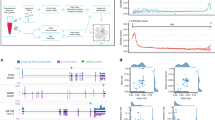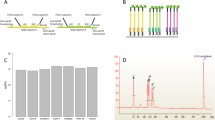Abstract
Minimal residual disease (MRD), the tumour burden which remains after a course of treatment that has resulted in clinical remission [1], appears to differ in certain characteristics from the primary tumour population. Certainly the cells which comprise MRD have had to escape from the constraints of the primary tumour mass, invade normal tissue and penetrate small vessels in order to enter the circulation in which they then have had to survive. Such activities are the consequence of the expression of specific proteins and these may well be a reflection of alterations in DNA or RNA levels. Identifying the changes in RNA expression levels between related cell groups exhibiting different phenotypes recently has become a great deal easier as a consequence of developments in analytical procedures such as Differential Display (DD) and Serial Analysis of Gene Expression (SAGE). Application of these procedures to MRD cells recovered from blood, bone marrow or lymph node, should identify novel sequences associated with tumour progression and the development of disseminated disease.
Similar content being viewed by others
References
Cheryl HG: Detection of minimal residual disease: Relevance for diagnosis and treatment of human malignancies. Ann Rev Med 49: 111–122, 1998
Meyer T, Hart IR: Mechanisms of tumour metastasis. Eur J Cancer 34: 214–221, 1998
Fidler IJ, Kripke ML: Metastasis results from pre-existing variant cells within a malignant tumor. Science 197: 893–895, 1977
Poste G, Fidler IJ: The pathogenesis of cancer metastasis. Nature 242: 148–152, 1980
Sager R: Expression genetics in cancer: Shifting the focus from DNA to RNA. Proc Natl Acad Sci USA 94: 952–955, 1997
Dorudi S, Sheffield JP, Poulsom R, Northover JMA, Hart IR: E-cadherin expression in colorectal cancer: An immunocytochemical and in situ hybridization study. Am J Path 142: 981–986, 1992
Charpin C, Garcia S, Bouvier C, Devictor B, Andrac L, Choux R, et al.: E-cadherin quantitative immunocytochemical assays in breast carcinomas. J Pathol 181: 294–300, 1997
Gamallo C, Palacios J, Benito N, Limeres MA, Pizarro A, Suarez A, et al.: Expression of E-cadherin in 230 infiltrating ductal breast carcinoma: Relationship to clinicopathological features. Int J Oncol 9: 1207–1212, 1996
Hynes RO: Integrins: versatility, modulation, and signalling in cell adhesion. Cell 69: 11–25, 1992
Albelda SM, Mette SA, Elder DE, Stewart RM, Damjanovich L, Herlyn M, et al.: Integrin distribution in malignant-melanoma — Association of the β3 subunit with tumor progression. Cancer Res 50: 6757–6764, 1990
Marshall JF, Hart IR: The role of αv-integrins in tumour progression and metastasis. Seminars in Cancer Biol 7: 129–138, 1996
Klein G, Klein E: Evolution of tumours and the impact of molecular oncology. Nature 315: 190–195, 1985
Matzku S, Wenzel A, Liu S, Zoller M: Antigenic differences between metastatic and non-metastatic BSP73 rat tumor variants characterized by monoclonal antibodies. Cancer Res 49: 1294–1299, 1989
Gunthert U, Hofmann M, Rudy W, Reber S, Zoller M, Haussmann I, et al.: A new variant of glycoprotein CD44 confers metastatic potential to rat carcinoma-cells. Cell 65: 13–24, 1991
Gunthert U: CD44 in malignant disorders. Current Topics in Microbiol and Immunol 213: 271–285, 1996
Johnson JP, Lehmann JM, Reithmuller G: Denovo expression of intercellular adhesion molecule-1 in melanoma correlates with increased risk of metastasis. Proc Natl Acad Sci USA 86: 641–644, 1989
Johnson JP: Cell-adhesion molecules of the immunoglobulin supergene family and their role in malignant transformation and progression to metastastic disease. Cancer Met Rev 10: 11–22, 1991
Johnson JP, Rothbacher U, Sers C: The progression associated antigen Muc18-A unique member of the immunoglobulin supergene family. Melanoma Res 3: 337–340, 1993
Kyprianou N, Issacs JT: Relationship between metastatic ability and H-ras oncogene expression in rat mammary cancer cells transfected with v-H-ras oncogene. Cancer Res 50: 1449–1453, 1990
Treiger B, Issacs JT: Expression of transfected v-Harveyras oncogene in a Dunning rat prostate adenocarcinoma and the development of high metastatic ability. J Urol 140: 1580–1586, 1988
Thorgeirsson UP, Turpeenieni-Hijanen T, Talmadge JE, Liotta LA: NIH3T3 cells transfected with human tumor DNA containing activated ras oncogenes express the metastatic phenotype in nude mice. Mol Cell Biol 5: 259–262, 1985
Davies BR, Barraclough R, Rudland PS: Induction of metastatic ability in a stably diploid benign rat mammary epithelial-cell line by transfection with DNA from human-malignant breast-carcinoma cell lines. Cancer Res 54: 2785–2793, 1994
Barraclough R, Rudland PS: The S-100-related calciumbinding protein, P9KA, and metastasis in rodent and human mammary cells. Eur J Cancer 30A: 1570–1576, 1994
Lloyd BH, PlattHiggins A, Rudland PS, Barraclough R: Human S100A4 (p9Ka) induces the metastatic phenotype upon benign tumour cells. Oncogene 17: 465–473, 1998
Tulchinksky EM, Grigorian MS, Ebralidze AK, Milshina NI, Lukanidin EM: Structure of gene MTS1, transcribed in metastatic mouse tumour cells. Gene 87: 219–223, 1990
Hart IR, Easty D: Identification of genes controlling metastatic behaviour. Br J Cancer 63: 9–12, 1991
Kallioniemi A, Kallioniemi OP, Sudar D, Rutovitz D, Gray JW, Waldman F, et al.: Comparative genomic hybridization for molecular cytogenetic analysis of solid tumors. Science 258: 818–821, 1992
Riopel MA, Spellerberg A, Griffin CA, Perlman EJ: Genetic analysis of ovarian germ cell tumors by comparative genomic hybridization. Cancer Res 58: 3105–3110, 1998
Popescu NC, Zimonjic DB: Molecular cytogenetic characterization of cancer cell alterations. Cancer Genetics and Cytogenetics 93: 10–21, 1997
Nishizaki T, DeVries S, Chew K, Goodson WH, Ljung BM, Thor A, et al.: Genetic alterations in primary breast cancers and their metastases: Direct comparison using modified comparative genomic hybridization. Genes, Chromosomes & Cancer 19: 267–272, 1997
Lee SW, Tomasetto C, Sager R: Positive selection of candidate tumor-suppressor genes by subtractive hybridization. Proc Natl Acad Sci USA 88: 2825–2829, 1991
Lisitsyn N, Lisitsyn N, Wigler M: Cloning the differences between two complex genomes. Science 259: 946–951, 1993
Wieland I, Bolger G, Wigler M: A method for difference cloning: Gene amplification following subtractive hybridization. Proc Natl Acad Sci USA 87: 2720–2724, 1990
Chambers AF, Hill RP: Tumor progression and metastasis. The Basic Science of Oncology (Ed 3) Tannock & Hill, 1998, pp 219–239
Liang P, Pardee AB: Differential display of eukaryotic messenger RNA by means of the polymerase chain reaction. Science 257: 967–971, 1992
Liang P, Averboukh L, Pardee AB: Distribution and cloning of eukaryotic messenger RNA by means of differential display: Refinements and optimization. Nucleic Acids Res 21: 3269–3257, 1993
Francia G, Mitchell SD, Moss SE, Hanby AM, Marshall JF, Hart IR: Identification by differential display of Annexin-VI; a gene differentially expressed during melanoma progression. Cancer Res 56: 55–58, 1996
Bertioli DJ, Schlichter UHA, Adams MJ, Burrow PR, Steinbib HH, Antoniw JF: An analysis of differential display shows a strong bias towards high copy numbermRNAs. Nucleic Acids Res 23: 4520–4523, 1995
Simon HG, Risse B, Jost M, Oppenheimer S, Kari C, Rodeck U: Identification of differentially expressed messenger RNAs in human melanocytes and melanoma cells. Cancer Res 56: 3112–3117, 1996
Kao RH, Poulsom R, Hanby AM, Francia G, Hart IR: Identification by differential display of genes expressed in breast cancer. Br J Cancer 78: 33, 1998
MacDonald C, Willett B: The immortalisation of rat hepatocytes by transfection with SV40 sequences. Cytotechnology 23: 161–170, 1997
Hubank M, Schatz DG: Identifying differences in mRNA expression by representational differences analysis of cDNA. Nucleic Acids Res 22: 5640–5648, 1994
Diatchenko L, Lau YFC, Campbell AP, Chenchik A, Moqadam F, Huang B, et al.: Suppression subtractive hybridization: A method for generating differentially regulated or tissue-specific cDNAprobes and libraries. Proc Natl Acad Sci USA 93: 6025–6030, 1996
Gurskaya N, Diatchenko L, Chenchik A, Siebert PD, Khaspekov GL, Lukyanov KA, et al.: Equalizing cDNA subtraction based on selective suppression of polymerase chain reaction: Cloning of Jurkat cell transcripts induced by phytohemaglutinin and phorbol 12-myristate 13-acetate. Anal Biochem 240: 90–97, 1996
Siebert PD, Chenchik A, Kellogg DE, Lukyanov KA, Lukyanov SA: An improved PCR method for walking in uncloned genomic DNA. Nucleic Acids Res 23: 1087–1088, 1995
Velculescu VE, Zhang L, Vogelstein B, Kinzler KW: Serial analysis of gene expression. Science 270: 484–487, 1995
Zhang L, Zhou W, Velculescu VE, Kern SE, Hruban RH, Hamilton SR, et al.: Gene expression profiles in normal and cancer cells. Science 276: 1268–1272, 1997
Powell J: Enhanced concatemer cloning — a modification to the SAGE (Serial Analysis of Gene Expression) technique. Nucleic Acids Res 26: 3445–3446, 1998
Scheunemann P, Hosch SB, Witter K, Putz E, Zhan R, Schneider C, et al.: Establishment and comparative characterization of two new human esophageal carcinoma cell lines derived from lymph node micrometastatic cells and autologous primary tumor. Gastroenterology 114: G2778, 1998
Schena M, Shalon D, Davis RW, Brown PO: Quantiative monitoring of gene expression patterns with a complementary DNA microarray. Science 270: 467–470, 1995
DeRisi J, Penaland L, Brown PO, Bittner ML, Meltzer PS, Ray M, et al.: Use of cDNA microarray to analyse gene expression patterns in human cancer. Nat Genet 14: 457–460, 1996
Welford SM, Gregg J, Chen E, Garrison D, Sorensen PH, Denny CT, et al.: Detection of differentially expressed genes in primary tumor tissues using representational differences analysis coupled to microarray hybridization. Nucleic Acids Res 26: 3059–3065, 1998
Kang DC, LaFrance R, Su ZZ, Fisher PB: Reciprocal subtraction differential RNA display: An efficient and rapid procedure for isolating differentially expressed gene sequences. Proc Natl Acad Sci USA 95: 13788–13793, 1998
Wang SM, Rowley JD: A strategy for genome-wide gene analysis: Integrated procedure for gene identification. Proc Natl Acad Sci USA 95: 11909–11914, 1998
Kerbel RS, Waghorne C, Korczak B, Lagarde A, Breitman ML: Clonal dominance of primary tumours by metastatic cells: genetic analysis and biological implications. Cancer Surveys 7: 597–629, 1988
Ross AA: Minimal residual disease in solid tumor malignancies: A review. Journal of Hematotherapy 7: 9–18, 1998
Author information
Authors and Affiliations
Rights and permissions
About this article
Cite this article
Kao, R.H., von Schlippe, M., Francia, G. et al. Identification of Changes in Gene Expression Associated with Minimal Residual Disease. Cancer Metastasis Rev 18, 3–13 (1999). https://doi.org/10.1023/A:1006243917187
Issue Date:
DOI: https://doi.org/10.1023/A:1006243917187




